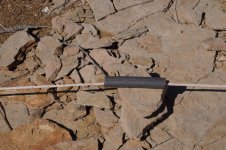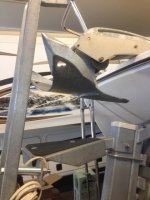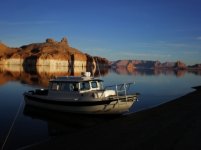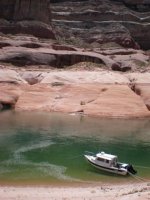At the Recent Lake Powell gathering I noticed that "new" boats to Powell were not equipped or did not understand anchoring under the conditions found there. During our trip this year, we had winds in excess of 40 knots on 3 occasions, so winds can be expected up there, and a good set of the anchor is essential. Also the type of anchor is important. We had used a Delta Quick set in the past, but on an average had drug on 2 nights out of a 2 to 4 week trip. This year, we went with a light weight "Boss" From Manson supreme. This anchor did not drag, and set quickly, on a short scope. At the gathering we noted Claw or Bruce type, Delta, Manson Supreme and Boss, Fortress, and Danforth anchors. There may have been some others--I know that Jody set a "box" anchor.
When looking for an anchoring area, look for good sand, with no brush under the water at the set point (there may be some brush between you and the bank. We always run over the area several times with the depth sounder, as well as put the bow near the beach to look for rocks or other obstructions before we drop the hook. We use the depth finder--and now the "down scan" gives us an even better picture of the bottom.
Here is RIGI setting their hook well off the beach properly:
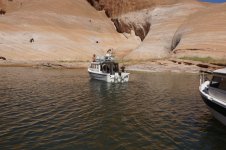
In this area, we had about 7: 1 scope out.
When you back to the shore, let plenty of line out, to an at least 3:1 scope and see if the anchor is set. We let the full weight of the boat come back, and check for dragging, by applying reverse thrust. As this point we estimate how far back the boat will have to come, before we come back to the beach were the crew can step off, in water which is not too deep and yet deep enough that the trim tabs, depth sounder transducers or engine lower units will hit. Sometimes this backing down, may take several tries, and of course it is better to have the depth too deep, and avoid damage to the lower units! We start to bring the lower unit to the depth where it is still getting enough cooling water, but will easily come up, clear of the water when we stop the engine as the mate steps ashore.
RIGI is just at the right depth, the crew ashore is in shoal water and ready to take one of the two anchors ashoreL
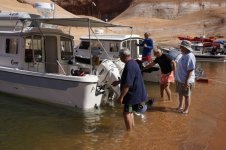
We happen to use two light weight Fortress or Guardian anchors, with about 6 feet of 1/4" chain attached, and 3/8" or 5/16" line.
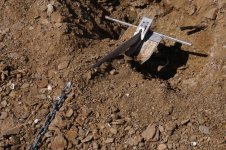
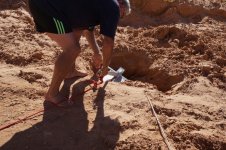
The second anchor is then taken ashore:

Some folks use steel stakes (or even PVC pipe) hammered into the ground:
 This stake is Pat Anderson's and has several toggles to increase its holding. We have seen straight steel stakes, and even old fence posts.
This stake is Pat Anderson's and has several toggles to increase its holding. We have seen straight steel stakes, and even old fence posts.
Also we used a "deadman" such as a rock or log buried:
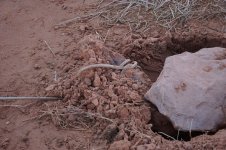
In another case a mushroom anchor was buried:

Finally we finish off the moor with two spring lines from the main rode, which will prevent bow roller chafe, and allow a little more shock absorption. When heavy winds we tend to pull a bit off the shore. Note we never leave the anchor rode on the windlass:
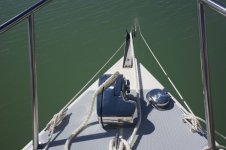
Finally at Lake Powell we want to avoid critters--several folks have had ring tail cats, and kangaroo rats come aboard, so a rat guard is appropriate:
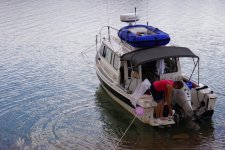
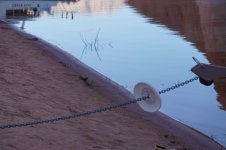
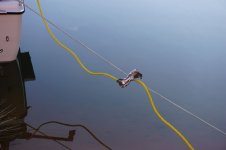
Note that Frisbies are the item of choice--but I suspect the foil may also work.
Some folks come bow to the beach--usually a bow anchor buried in a hole on the beach, and or two stern anchors from each aft quarter:
Such as Discovery and C View II
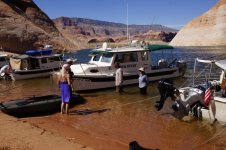
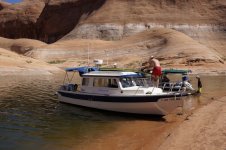
(note that Discovery has a "pocket dog"--those of us with slightly larger dogs like to go stern to, to easy their way ashore…. Both of these boats have bow ladders)
When looking for an anchoring area, look for good sand, with no brush under the water at the set point (there may be some brush between you and the bank. We always run over the area several times with the depth sounder, as well as put the bow near the beach to look for rocks or other obstructions before we drop the hook. We use the depth finder--and now the "down scan" gives us an even better picture of the bottom.
Here is RIGI setting their hook well off the beach properly:

In this area, we had about 7: 1 scope out.
When you back to the shore, let plenty of line out, to an at least 3:1 scope and see if the anchor is set. We let the full weight of the boat come back, and check for dragging, by applying reverse thrust. As this point we estimate how far back the boat will have to come, before we come back to the beach were the crew can step off, in water which is not too deep and yet deep enough that the trim tabs, depth sounder transducers or engine lower units will hit. Sometimes this backing down, may take several tries, and of course it is better to have the depth too deep, and avoid damage to the lower units! We start to bring the lower unit to the depth where it is still getting enough cooling water, but will easily come up, clear of the water when we stop the engine as the mate steps ashore.
RIGI is just at the right depth, the crew ashore is in shoal water and ready to take one of the two anchors ashoreL

We happen to use two light weight Fortress or Guardian anchors, with about 6 feet of 1/4" chain attached, and 3/8" or 5/16" line.


The second anchor is then taken ashore:

Some folks use steel stakes (or even PVC pipe) hammered into the ground:
 This stake is Pat Anderson's and has several toggles to increase its holding. We have seen straight steel stakes, and even old fence posts.
This stake is Pat Anderson's and has several toggles to increase its holding. We have seen straight steel stakes, and even old fence posts.Also we used a "deadman" such as a rock or log buried:

In another case a mushroom anchor was buried:

Finally we finish off the moor with two spring lines from the main rode, which will prevent bow roller chafe, and allow a little more shock absorption. When heavy winds we tend to pull a bit off the shore. Note we never leave the anchor rode on the windlass:

Finally at Lake Powell we want to avoid critters--several folks have had ring tail cats, and kangaroo rats come aboard, so a rat guard is appropriate:



Note that Frisbies are the item of choice--but I suspect the foil may also work.
Some folks come bow to the beach--usually a bow anchor buried in a hole on the beach, and or two stern anchors from each aft quarter:
Such as Discovery and C View II


(note that Discovery has a "pocket dog"--those of us with slightly larger dogs like to go stern to, to easy their way ashore…. Both of these boats have bow ladders)

